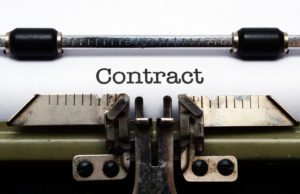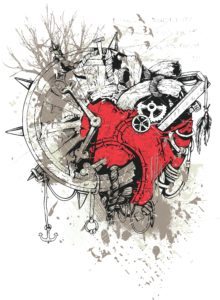Quick links, bringing you great articles on writing from all over the web.
 Hybrid publishing is an emerging area that occupies the middle ground between traditional and self-publishing and therefore includes many different publishing models— basically anything that is not self-publishing or traditional publishing. “Hybrid publishing” is not a term all publishers or authors in this space use; other terms that describe this type of publishing include “author-assisted publishing,” “independent publishing,” “partnership publishing,” “copublishing,” and “entrepreneurial publishing.” But right now, because it’s a catchall, “hybrid publishing” is the umbrella term I’ll use throughout this book to refer to this middle ground.
Hybrid publishing is an emerging area that occupies the middle ground between traditional and self-publishing and therefore includes many different publishing models— basically anything that is not self-publishing or traditional publishing. “Hybrid publishing” is not a term all publishers or authors in this space use; other terms that describe this type of publishing include “author-assisted publishing,” “independent publishing,” “partnership publishing,” “copublishing,” and “entrepreneurial publishing.” But right now, because it’s a catchall, “hybrid publishing” is the umbrella term I’ll use throughout this book to refer to this middle ground.
This guest post is Brooke Warner. Warner is publisher of She Writes Press, president of Warner Coaching Inc., and author of Green-Light Your Book, What’s Your Book?, and How to Sell Your Memoir, and the co-author of Breaking Ground on Your Memoir. Brooke’s expertise is in traditional and new publishing, and she is an equal advocate for publishing with a traditional house and self-publishing. She sits on the board of the Independent Book Publishers Association (IBPA), the Bay Area Book Festival, and the National Association of Memoir Writers (NAMW). She blogs actively on Huffington Post Books and SheWrites.com. She lives and works in Berkeley, California.
The hybrid publishing space is somewhat controversial, in part because it’s new and in part because there’s no universal agreement about what it is. Because hybrid models almost always involve the author paying for some or all services (and always in return for higher royalty rates), some assert that hybrid publishing is the same as vanity publishing. For people who like to think in black-and-white terms, the hybrid publishing space upends their sense of order. Without hybrid, there are’ just traditional publishing and self-publishing. Black and white. You get paid to publish or you pay to get published. The hybrid publishing space is not for black-and-white thinkers. There are a number of models, and in my experience what sets them apart from vanity presses is that they’re run like publishing companies. Many of them have a submissions process, control their own cover design and editorial process, and have publishers calling the shots and curating the lists. There are also traditional publishers that are cutting hybrid deals, in which authors pay for some services in exchange for higher royalties.
Read the full post on The Writer’s Dig
~ * ~
If you liked this article, please share. If you have suggestions for further articles, articles you would like to submit, or just general comments, please contact me at paula@publetariat.com or leave a message below.

 When I reached the end of my first draft of
When I reached the end of my first draft of  Following up on
Following up on  When I talk with authors about
When I talk with authors about  Hybrid publishing is an emerging area that occupies the middle ground between traditional and self-publishing and therefore includes many different publishing models— basically anything that is not self-publishing or traditional publishing. “Hybrid publishing” is not a term all publishers or authors in this space use; other terms that describe this type of publishing include “author-assisted publishing,” “independent publishing,” “partnership publishing,” “copublishing,” and “entrepreneurial publishing.” But right now, because it’s a catchall, “hybrid publishing” is the umbrella term I’ll use throughout this book to refer to this middle ground.
Hybrid publishing is an emerging area that occupies the middle ground between traditional and self-publishing and therefore includes many different publishing models— basically anything that is not self-publishing or traditional publishing. “Hybrid publishing” is not a term all publishers or authors in this space use; other terms that describe this type of publishing include “author-assisted publishing,” “independent publishing,” “partnership publishing,” “copublishing,” and “entrepreneurial publishing.” But right now, because it’s a catchall, “hybrid publishing” is the umbrella term I’ll use throughout this book to refer to this middle ground. One of the things a good copyeditor will do, beyond dealing with infelicities of grammar, syntax, style, composition, and general meaning, is cover your back. And I mean totally cover it.
One of the things a good copyeditor will do, beyond dealing with infelicities of grammar, syntax, style, composition, and general meaning, is cover your back. And I mean totally cover it. After October’s inaugural, myth-busting post
After October’s inaugural, myth-busting post  In Japan, after World War II, the concept of kaizen was introduced into their industrial culture. It resulted in a huge boom in technology and manufacturing that rebuilt Japan and made her prosperous.
In Japan, after World War II, the concept of kaizen was introduced into their industrial culture. It resulted in a huge boom in technology and manufacturing that rebuilt Japan and made her prosperous. A lot of focus gets put on the core conflict of a novel–the main problem the protagonist has to solve to win. It’s no wonder since that’s the whole point of the book, but sometimes, when we look too hard at the external problems, we miss out on opportunities to let the internal problems muck things up. This is especially true in a character-driven novel, since that inner journey is what’s driving the entire book.If you’ve been struggling with a plot, or you’re looking for ways to deepen an existing plot, try looking at how your protagonist’s internal conflict is driving her external actions.
A lot of focus gets put on the core conflict of a novel–the main problem the protagonist has to solve to win. It’s no wonder since that’s the whole point of the book, but sometimes, when we look too hard at the external problems, we miss out on opportunities to let the internal problems muck things up. This is especially true in a character-driven novel, since that inner journey is what’s driving the entire book.If you’ve been struggling with a plot, or you’re looking for ways to deepen an existing plot, try looking at how your protagonist’s internal conflict is driving her external actions.
 If you’re not watching the excellent HBO series
If you’re not watching the excellent HBO series  Posted on
Posted on  It turns out Author Anxiety is a Thing. It’s not just me.
It turns out Author Anxiety is a Thing. It’s not just me. Instagram has seen staggering growth since Facebook purchased it. And every day, more authors are beginning to use it, with great success, to engage their readers, build their fan base, and sell books. And here’s why:
Instagram has seen staggering growth since Facebook purchased it. And every day, more authors are beginning to use it, with great success, to engage their readers, build their fan base, and sell books. And here’s why: Hi everyone! This is the first installment of a new series I’m going to be writing here at Pub Crawl: Clause by Clause. As our resident contracts expert, I’m going to do my best to demystify this part of the publishing process for you, one clause at a time. Today I’m talking about Option Clauses.What is an Option Clause?
Hi everyone! This is the first installment of a new series I’m going to be writing here at Pub Crawl: Clause by Clause. As our resident contracts expert, I’m going to do my best to demystify this part of the publishing process for you, one clause at a time. Today I’m talking about Option Clauses.What is an Option Clause? Emily Wenstrom
Emily Wenstrom